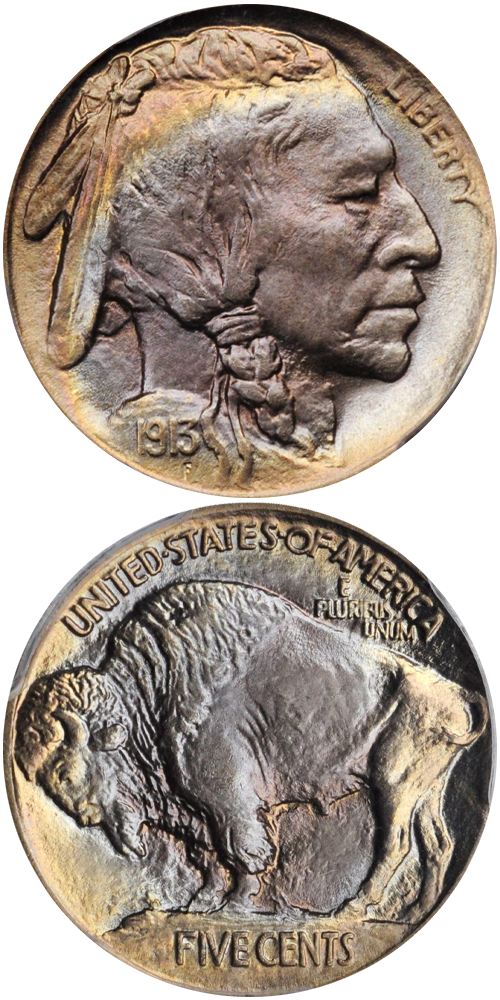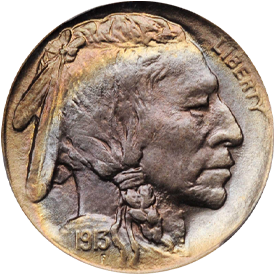Designed by: James E. Fraser
Issue Date: 1913
Composition: 75% copper, 25% nickel
Diameter: 21.2 mm
Weight: 5.00 grams (77.16 grains)
Edge: Plain
Business Strike Mintage: 38,434,270
Like the Liberty or “V” nickel that preceded it, the very first issue of James Earl Frazer’s new Indian or “Buffalo” nickel in 1913 was quickly changed. The denomination “Five Cents” at the bottom on the reverse was raised well above the fields and found to be vulnerable to wear. After several years of circulation, it was thought that this denominational information would be lost, and so a new design in which the denomination was recessed was quickly introduced later that same year. Today, collectors refer to the earlier design as the Buffalo on the “mound” or “raised ground” (Type I) and the later modification as the “plain” or “recessed ground” (Type II).
Because it was quickly changed, many collectors (as had been seen with the 1883 “No Cents” nickel some 30 years earlier) saved the earlier type, and consequently, both the 1883 “No Cents” nickel and the 1913 “Raised Ground” nickel are relatively available in high grade today.
Due to the hardness of the copper-nickel alloy, many issues of the Buffalo nickel are weakly struck, lacking fine detail on both the Indian and particularly the buffalo on the reverse.
Also like the Liberty nickel, the Buffalo nickel circulated during an era in which five cents had real purchasing power, and examples in low grade could be found in circulation up through the mid-1960s.
Unfortunately, the date was also raised to a high point on the design, but apparently mint officials did not view the loss of a date as particularly serious and this design anomaly was never corrected. As the coins wore, the date disappeared, and as a consequence, a great many Buffalo nickels circulating after the 1950s became “dateless” examples.
Further Reading
In 1913 a new nickel design appeared, the Indian or Buffalo style. Although reference books sometimes call these “Indian head nickels,” nearly all numismatists as well as citizens in general prefer the "Buffalo nickel" term. Perhaps the “Indian” designation is special and is reserved for Indian cents. The nomenclature is further confused by the fact that the creature on the reverse of this particular design is not a buffalo at all but, properly speaking, is a bison. Presumably zoologists know the difference, but most numismatists could care less!
The obverse bears a realistic portrait of an Indian modeled by sculptor James E. Fraser, who used three different Indians to create a composite. The bison on the reverse is a likeness of Black Diamond, who resided for many years in a New York zoo.
Buffalo nickels are of two main varieties, usually referred to as Type I and Type II. Both are necessary to complete a type set. The first style was coined only at the beginning of 1913 and features the buffalo (I defer to popular usage as bison would seem strange) on a raised mound. Soon apparent was the fact that the design would wear too quickly, so it was revised to portray the buffalo on a plain. The words FIVE CENTS, formerly in prominent relief on the mound, were relocated to a more protected position below the line formed by the plain.
Buffalo nickels were made from 1913 through 1938 inclusive. In contrast to the Shield and Liberty styles of an earlier era, Buffalo nickels are more like a medal than a coin. There is very little "field" or flat area on either the obverse or the reverse. The coins are almost sculpted in appearance.
A number of interesting scarcities and varieties occur throughout the series. As noted, 1913 was made in two types. Specimens of each were struck at Philadelphia, Denver, and San Francisco.
The high relief of the Buffalo design combined with the hardness of nickel metal made striking a problem. As a result, well struck pieces are the exception rather than rule. Examples are nearly always lightly impressed in certain portions.
The collector assembling a set of Buffalo nickels soon learns what reasonable expectations are regarding sharpness of details. The building of a completely sharply struck set of nickels from 1913 to 1938 may not be a theoretical impossibility, but considering the life span and patience of the average collector, it is a practical impossibility. I have never seen it done!
As is the case with any rare coin, the best protection for authenticity is to buy only certified coins from one of the major services or from an established dealer who guarantees his merchandise. Fabrications are not bargains at any price. Another interesting sham has been conducted from time to time by nickel-plating worn specimens of Buffalo nickels, thus giving them a bright appearance. However, the surfaces are not quite correct and the edges differ on such pieces.
For the collector interested in assembling a set of date and mintmark varieties, a condition expectation of Extremely Fine to AU for issues from 1913 through 1929 (although 1913 Type I is readily available in Uncirculated grade) is reasonable, with the balance of the set from 1930 onward in Uncirculated preservation. Budget permitting, trying for a complete Uncirculated set is a real challenge, but, as always, it is important to be realistic about expectations for sharpness among Denver and San Francisco coins.







